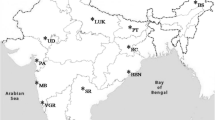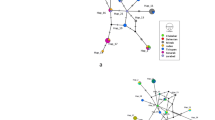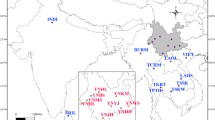Abstract
Population genetic structure of melon fly analysed with mitochondrial cytochrome oxidase I gene suggested that melon fly populations across the globe is homogeneous with non-significant variation of 0.000–0.003 base substitutions per site. Test isolates representing various geographic situations across the world were placed in 26 mitochondrial haplotypes based on variations associated with a maximum of three mutational steps and the predominant haplotype i.e. H1 was present in all melon fly populations except Hawaiian population. Evolution of mtCOI gene suggested that the fly could have originated some 0.4 million years ago. The present study also indicated that the B. cucurbitae population expansion is an event of post Pleistocene warm climatic conditions with small number of founder population. The invasion of B. cucurbitae in Hawaii was associated with the large population size and the global presence of the fly is associated with human mediated dispersal. The very low genetic variation suggested that the fly management might be possible by large scale sterile insect techniques programme.


Similar content being viewed by others
References
Armstrong KF, Ball SL (2005) DNA barcodes for biosecurity: invasive species identification. Philos Trans R Soc Lond Biol Sci 360:1813–1823
Avise JC (1994) Molecular markers, natural history and evolution. Chapman & Hall, London
Avise JC (2000) Phylogeography: the history and formation of species. Harvard University Press, Cambridge
Bermingham E, Lessios HA (1993) Rate variation of protein and mtDNA evolution as revealed by sea urchins separated by the Isthmus of Panama. PNAS 90:2734–2738
Bess HA, van den Bosch R, Haramoto FH (1961) Fruit fly parasites and their activities in Hawaii. Proc Hawaii Entomol Soc 27:367–378
Bezzi M (1913) Indian Tephritids (fruit flies) in the collection of the Indian Museum, Calcutta. Mem Indian Mus 3:153–175
Bilgin R, Karatas A, Çoraman E, Disotell T, Morales JC (2008) Regionally and climatically restricted patterns of distribution of genetic diversity in a migratory bat species, Miniopterus schreibersii (Chiroptera: Vespertilionidae). BMC Evol Biol 8:209
Brower AVZ (1994a) Phylogeny of Heliconius butterflies inferred from mitochondrial DNA sequences (Lepidoptera: Nymphalidae). Mol Phylogenet Evol 3:159–174
Brower AVZ (1994b) Rapid morphological radiation and convergence among races of the butterfly Heliconius erato inferred from patterns of mitochondrial DNA evolution. PNAS 91:6491–6495
Brown WM (1985) Molecular evolutionary genetics. In: MacIntyre RJ (ed) The mitochondrial genome of animals. Plenum Press, New York, pp 95–130
Brown WM, George M Jr, Wilson AC (1979) Rapid evolution of animal mitochondrial DNA. PNAS 76:1967–1971
Clement M, Posada D, Crandall KA (2000) TCS: a computer program to estimate gene genealogies. Mol Ecol 9:1657–1660
Dhillon MK, Singh R, Naresh JS, Sharma HC (2005) The melon fruit fly, Bactrocera cucurbitae: a review of its biology and management. J Insect Sci 5:1–16
Drew RAI, Raghu S (2002) The fruit fly fauna (Diptera: Tephritidae: Dacinae) of the rainforest habitat of the Western Ghats, India. Raffles Bull Zool 50:327–352
Eshleman JA, Malhi RS, Johnson JR, Kaestle FA, Lorenz J, Smith DG (2004) Mitochondrial DNA and prehistoric settlements: native migrations on the western edge of North America. Hum Biol 76:55–75
Excoffier L, Laval G, Schneider S (2005) Arlequin (version 3.0): an integrated software package for population genetics data analysis. Evol Bioinfor 1:47–50
Fabre F, Ryckewaert P, Duyck PF, Chiroleu F, Quilici S (2009) Comparison of the efficacy of different food attractants and their concentration for Melon Fly (Diptera: Tephritidae). J Econ Entomol 96:231–238
Felsenstein J (1985) Confidence limits on phylogenies: an approach using the bootstrap. Evolution 39:783–791
Fletcher BS (1987) The biology of Dacini fruit flies. Ann Rev Entomol 32:115–144
Fontem DA, Gumedzoe MYD, Nono WR (1999) Biological constraints in tomato production in the Western highlands of Cameroon. Tropicultura 16(17):89–92
Hollingsworth R, Allwood AJ (2002) Melon fly. In: SPC pest advisory leaflets. pp 1–2
Hu J, Zhang JL, Nardi F, Zhang RJ (2008) Population genetic structure of the melon fly, Bactrocera cucurbitae (Diptera: Tephritidae), from China and Southeast Asia. Genetica 134:319–324
Jamnongluk W, Baimai V, Kittayapong P (2003) Molecular evolution of tephritid fruit flies in the genus Bactrocera based on the cytochrome oxidase I gene. Genetica 119:19–25
Koyama J, Kakinohana H, Miyatake T (2004) Eradication of the melon fly, Bactrocera cucurbitae, in Japan: importance of behaviour, ecology, genetics, and evolution. Ann Rev Entomol 49:331–349
Lunt DH, Zhang DX, Szymura JM, Hewitt GM (1996) The insect cytochrome oxidase I gene: evolutionary patterns and conserved primers for phylogenetic studies. Insect Mol Biol 5:153–165
Mun J, Bohonak AJ, Roderick GK (2003) Population structure of the pumpkin fruit fly Bactrocera depressa (Tephritidae) in Korea and Japan: Pliocene allopatry or recent invasion? Mol Ecol 12:2941–2951
Mwatawala M, De Meyer M, Makundi R, Maerere AP (2009) An overview of Bactrocera (Diptera: Tephritidae) invasions and their speculated dominancy over native fruit fly species in Tanzania. J Entomol 6:18–27
Nardi F, Carapelli A, Dallai R, Roderick GK, Frati F (2005) Population structure and colonization history of the olive fly, Bactrocera oleae (Diptera, Tephritidae). Mol Ecol 14:2729–2738
Ochando MD, Reyes A (2000) Genetic population structure in olive fly, Bactrocera oleae (Gmelin): gene flow and patterns of geographic differentiation. J Appl Entomol 124:177–183
Peccoud J, Simon J, McLaughlin HJ, Moran NA (2009) Post-Pleistocene radiation of the pea aphid complex revealed by rapidly evolving endosymbionts. PNAS 106:16315–16320
Pinero JC, Jacome I, Vargas R, Prokopy RJ (2006) Response of female melon fly, Bactrocera cucurbitae, to host-associated visual and olfactory stimuli. Entomol Exp Appl 12:261–269
Prabhakar CS, Sood P, Kapoor V, Kanwar SS, Mehta PK, Sharma PN (2009) Molecular and biochemical characterization of three bacterial symbionts of fruit fly, Bactrocera tau (Tephritidae: Diptera). J Gen Appl Microbiol 55:213–220
Saitou N, Nei M (1987) The neighbor-joining method: a new method for reconstructing phylogenetic trees. Mol Biol Evol 4:406–425
Shi W, Kerdelhue C, Ye H (2005) Population genetics of the Oriental fruit fly, Bactrocera dorsalis (Diptera: Tephritidae), in Yunnan (China) based on mitochondrial DNA sequences. Environ Entomol 34:977–983
Shi W, Kerdelhue C, Ye H (2010) Population genetic structure of the oriental fruit fly, Bactrocera dorsalis (Hendel) (Diptera: Tephritidae) from Yunnan province and nearby sites across the border. Genetica 138:377–385
Slatkin M, Hudson RR (1991) Pairwise comparisons of mitochondrial DNA sequences in stable and exponentially growing populations. Genetics 129:555–562
Sookar P, Haq I, Jessup A, McInnis D, Franz G, Wornoayporn V, Permalloo S (2010) Mating compatibility among Bactrocera cucurbitae (Diptera: Tephritidae) populations from three different origins. J Appl Entomol. doi:10.1111/j.1439-0418.2010.01576.x
Tamura K, Dudley J, Nei M, Kumar S (2007) MEGA4: molecular evolutionary genetics analysis (MEGA) software version 4.0. Mol Biol Evol 24:1596–1599
Tanaka M, Cabrera VM, Gonzalez AM, Larruga JM, Takeyasu T, Fuku N, Guo LJ, Hirose R, Fujita Y, Kurata M, Shinoda K, Umetsu K, Yamada Y, Oshida Y, Sato Y, Hattori N, Mizuno Y, Arai Y, Hirose N, Ohta S, Ogawa O, Tanaka Y, Kawamori R, Shamoto-Nagai M, Maruyama W, Shimokata H, Suzuki R, Shimodaira H (2004) Mitochondrial genome variation in eastern Asia and the peopling of Japan. Genome Res 14:1832–1850
Vayssieres JF, Rey JY, Traore L (2007) Distribution and host plants of Bactrocera cucurbitae in West and Central Africa. Fruits 62:391–396
Vayssieres JF, Carel Y, Coubes M, Duyck PF (2008) Development of immature stages and comparative demography of two cucurbit-attacking fruit flies in Re′union Island: Bactrocera cucurbitae and Dacus ciliatus. Environ Entomol 37:307–314
Virgilio M, Delatte H, Backeljau T, De Meyer M (2010) Macrogeographic population structuring in the cosmopolitan agricultural pest Bactrocera cucurbitae (Diptera: Tephritidae). Mol Ecol 19:2713–2724
Weems HV Jr, Heppner JB (2001) Melon fly, Bactrocera cucurbitae Coquillett (Insecta: Diptera: Tephritidae). Florida Department of Agriculture and Consumer Services, Division of Plant Industry, and T.R. Fasulo, University of Florida. University of Florida Publication EENY- 199
White IM, Elson-Harris MM (1992) Fruit flies of economic significance: their identification and bionomics. Centre for Agriculture and Biosciences International, Wallingford, p 601
Xie L, Hong XY, Xue XF (2006) Population genetic structure of the two spotted spider mite (Acari: Tetranychidae) from China. Annals Entomol Soc Am 99:959–965
Acknowledgments
Authors are thankful to the anonymous reviewers for their valuable comments and suggestions made for the improvement of the manuscript.
Author information
Authors and Affiliations
Corresponding author
Rights and permissions
About this article
Cite this article
Prabhakar, C.S., Mehta, P.K., Sood, P. et al. Population genetic structure of the melon fly, Bactrocera cucurbitae (Coquillett) (Diptera: Tephritidae) based on mitochondrial cytochrome oxidase (COI) gene sequences. Genetica 140, 83–91 (2012). https://doi.org/10.1007/s10709-012-9660-y
Received:
Accepted:
Published:
Issue Date:
DOI: https://doi.org/10.1007/s10709-012-9660-y




